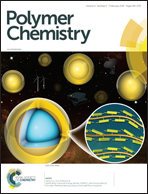Electrochemically mediated ATRP in ionic liquids: controlled polymerization of methyl acrylate in [BMIm][OTf]†
Abstract
Electrochemically mediated atom transfer radical polymerization (eATRP) of methyl acrylate (MA) was carried out for the first time in an ionic liquid, 1-butyl-3-methylimidazolium trifluoromethanesulfonate ([BMIm][OTf]). Ionic liquids are particularly suitable as solvents for eATRP because (i) a supporting electrolyte is not required, (ii) purification of the polymer is simple, and (iii) the catalyst can be recycled maintaining most of its original activity. Polymerization was relatively fast and well-controlled, affording polymers with a dispersity of ∼1.1 at >90% conversion in 2 h. Different conditions were explored, including applied potential, applied current, temperature, the monomer/solvent ratio, targeted degree of polymerization (from 276 to 828), and catalyst loading (down to 45 ppm). The livingness of MA polymerization was confirmed by realizing an electrochemical switch (ON/OFF toggling) and by the chain extension of poly(methyl acrylate)-Br with acrylonitrile. Chain extension was carried out for the first time by a “catalytic halogen exchange”, i.e. 180 ppm of a Cu complex was used to convert the chain end from C–Br to C–Cl. This afforded a well-controlled poly(methyl acrylate)-b-poly(acrylonitrile)-Cl copolymer.
![Graphical abstract: Electrochemically mediated ATRP in ionic liquids: controlled polymerization of methyl acrylate in [BMIm][OTf]](/en/Image/Get?imageInfo.ImageType=GA&imageInfo.ImageIdentifier.ManuscriptID=C7PY02134H&imageInfo.ImageIdentifier.Year=2018)


 Please wait while we load your content...
Please wait while we load your content...